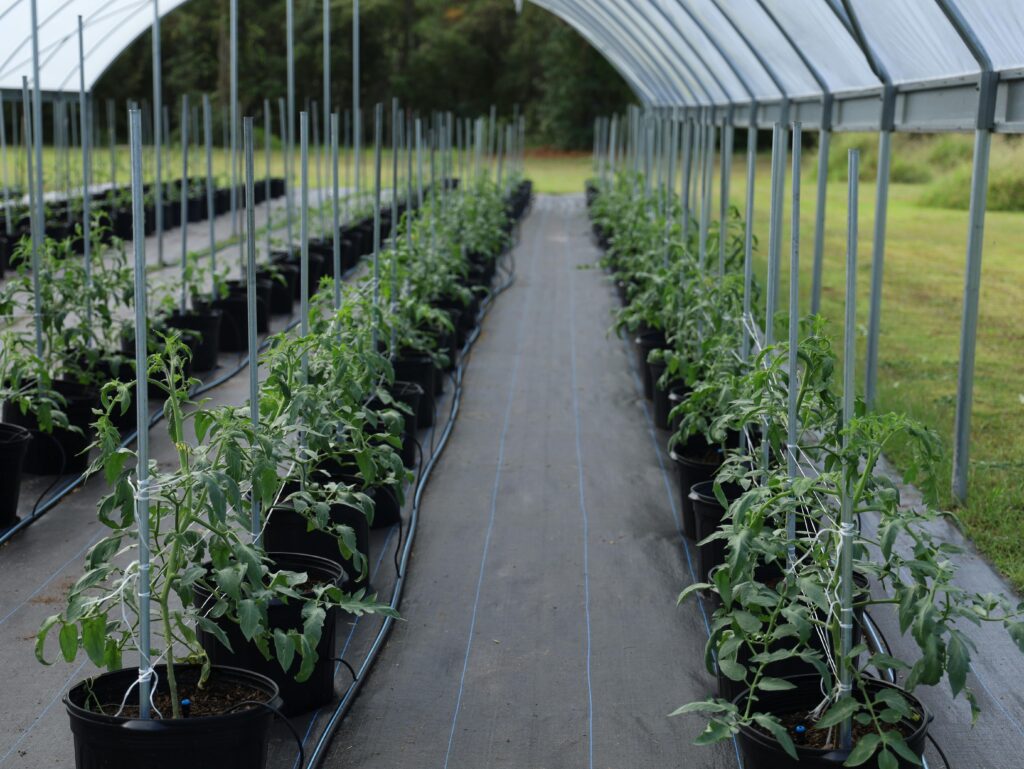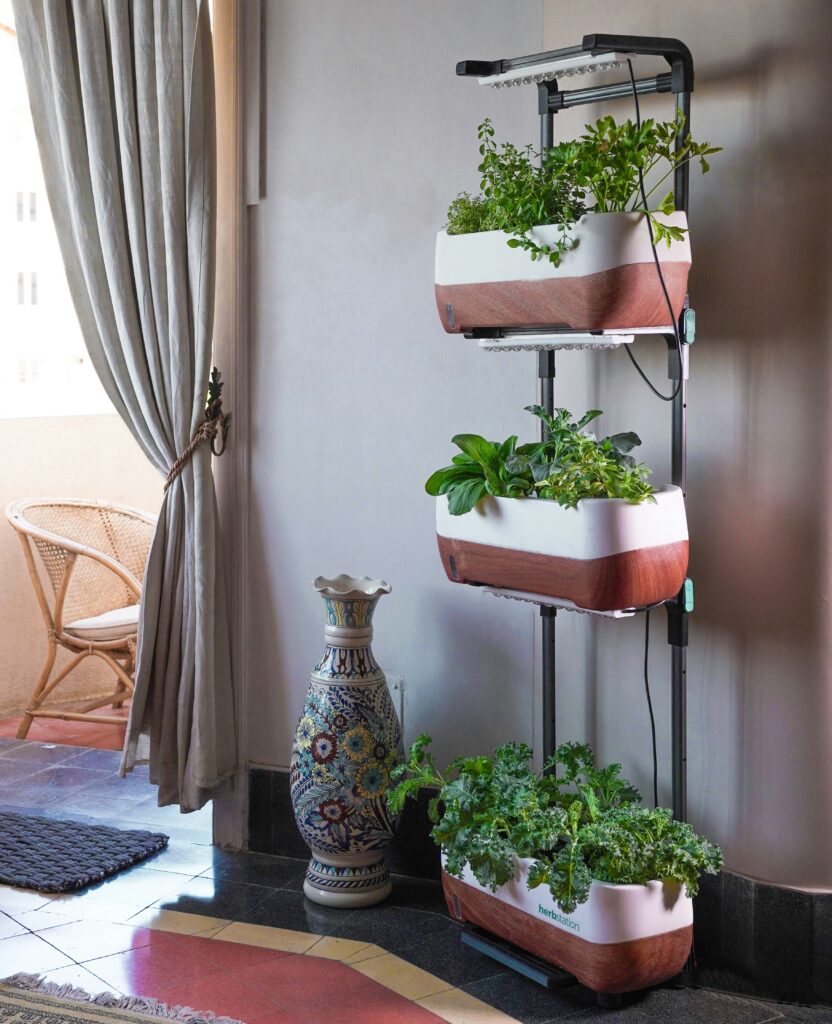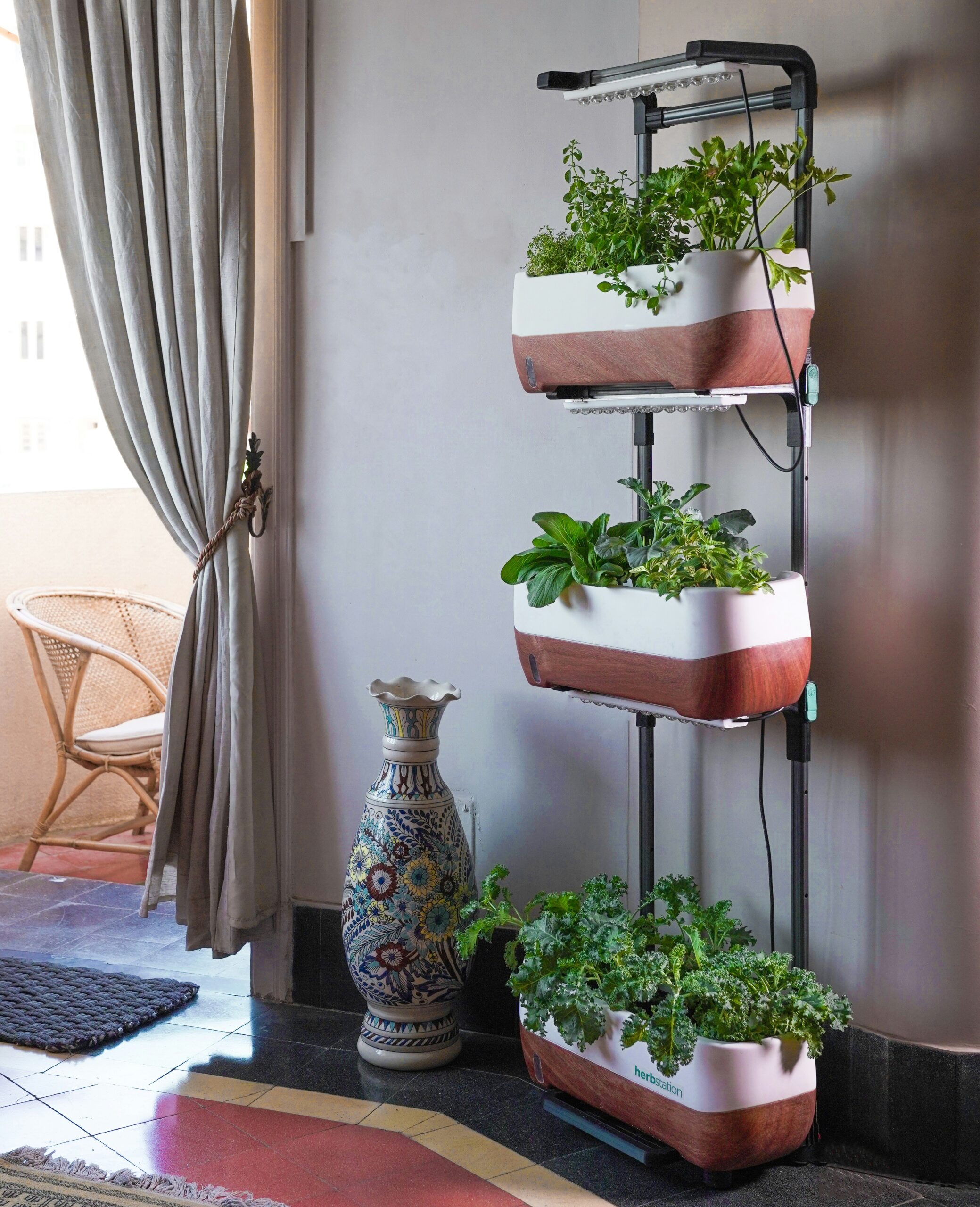The Benefits of Vertical Gardening and How to Get Started
Table of Contents
Introduction
In today’s fast-paced world, the desire to reconnect with nature and grow our own food is stronger than ever. However, with limited space in urban environments and busy lifestyles, traditional gardening methods may seem impractical. This is where vertical gardening comes into play, offering a solution that maximizes space and minimizes effort while reaping a multitude of benefits. In this comprehensive guide, we’ll delve into the advantages of vertical gardening and address 10 frequently asked questions to help you get started on your green journey.
Vertical gardening is a unique and innovative approach to gardening that has gained popularity in recent years. This technique involves growing plants vertically, either against a wall, on a trellis, or in a vertical planter. Not only does vertical gardening make the most of limited space, but it also offers numerous other benefits that traditional gardening methods may not provide.

What is Vertical Gardening?
Vertical gardening is a gardening technique that involves growing plants vertically, either on walls, trellises, fences, or other upright structures, rather than in traditional horizontal beds or plots. This method utilizes both horizontal and vertical space efficiently, allowing gardeners to cultivate a variety of plants even in limited areas.
Vertical gardening can take many forms, ranging from simple trellises for climbing plants to elaborate living walls or green facades. The goal is to maximize the use of available space while creating visually appealing and functional garden areas.
Plants in vertical gardens are typically grown in containers, pouches, or modular systems that can be mounted or hung on vertical surfaces. This allows for flexibility in plant selection and arrangement, as well as easier maintenance and care.
Vertical gardening is particularly popular in urban environments where space is limited, as it enables individuals to create green oases in small yards, balconies, rooftops, or even indoors. It offers numerous benefits, including maximizing space utilization, enhancing aesthetic appeal, promoting biodiversity, and providing opportunities for sustainable food production.
Benefits of Vertical Gardening
Vertical gardening offers a plethora of benefits, making it an attractive option for urban dwellers, gardening enthusiasts, and sustainability advocates alike. Here are some of the key advantages:

- Maximizing Space Utilization: Vertical gardening allows gardeners to make the most of limited space by utilizing both horizontal and vertical surfaces. This is particularly beneficial in urban environments where space is at a premium, enabling individuals to create green spaces in small yards, balconies, rooftops, or even indoors.
- Enhanced Aesthetic Appeal: Vertical gardens can transform plain walls or structures into vibrant and visually appealing spaces. They serve as living artworks, adding color, texture, and natural beauty to urban landscapes and indoor environments.
- Improved Air Quality: Plants naturally absorb carbon dioxide and release oxygen through photosynthesis, contributing to cleaner air. Vertical gardens increase the overall greenery in urban areas, helping to mitigate air pollution and create healthier environments for residents.
- Efficient Water Usage: Vertical gardening systems often incorporate innovative irrigation methods, such as drip systems or hydroponics, which optimize water usage. These systems deliver water directly to plant roots, minimizing wastage and promoting water conservation.
- Biodiversity Promotion: Vertical gardens provide habitats for various plant species, attracting beneficial insects, birds, and other wildlife. By fostering biodiversity, they contribute to ecosystem health and resilience, even in densely populated urban settings.
- Temperature Regulation: Plants on vertical surfaces can provide natural insulation, reducing heat absorption and cooling surrounding areas. This effect helps mitigate the urban heat island effect, making cities more comfortable and energy-efficient.
- Noise Reduction: Plants have the ability to absorb sound, making vertical gardens effective natural sound barriers. By dampening noise pollution, they create quieter and more peaceful outdoor spaces, especially in busy urban environments.
- Easy Accessibility: Vertical gardens can be designed at various heights, making them accessible to people of all ages and physical abilities. Whether installed at ground level or elevated, they offer convenient gardening opportunities for everyone.
- Sustainable Food Production: Vertical gardens allow individuals to grow their own fresh produce, even in urban apartments or homes with limited outdoor space. By cultivating herbs, vegetables, and fruits vertically, gardeners can reduce their reliance on store-bought produce and promote food sustainability.
- Stress Reduction: Engaging with nature has been scientifically proven to reduce stress levels and improve overall well-being. Vertical gardens provide a therapeutic escape from the hustle and bustle of city life, offering moments of tranquility and connection with the natural world.
Overall, vertical gardening offers a multitude of benefits, ranging from practical space-saving solutions to environmental and health advantages. By incorporating vertical gardens into urban landscapes and indoor spaces, individuals can create greener, healthier, and more sustainable environments for themselves and future generations.

How to Get Started with Vertical Gardening
Getting started with vertical gardening is an exciting journey that offers endless possibilities for creativity and greenery. Here’s a step-by-step guide to help you kickstart your vertical gardening adventure:
1. Assess Your Space:
- Evaluate the available space where you intend to create your vertical garden. Consider factors such as sunlight exposure, access to water, and structural integrity of vertical surfaces.
2. Choose Your Plants:
- Select plants that are suitable for vertical gardening and compatible with your climate and growing conditions. Opt for a mix of trailing, climbing, and upright plants to create visual interest and maximize space utilization.
3. Select a Vertical Gardening System:
- Choose a vertical gardening system that best suits your space, budget, and aesthetic preferences. Options include wall-mounted planters, trellises, modular systems, or DIY solutions such as pallet gardens or repurposed containers.
4. Prepare Your Vertical Surface:
- Ensure that the vertical surface where you’ll be installing your garden is clean, stable, and adequately supported. Repair any structural damage and apply a waterproof membrane if necessary to protect the surface from moisture damage.
5. Install Your Vertical Garden:
- Follow the manufacturer’s instructions or DIY tutorials to install your chosen vertical gardening system securely. Make sure to leave enough space between plants for growth and proper airflow.
6. Plant Your Garden:
- Carefully plant your chosen plants in the vertical gardening containers or pockets, ensuring that each plant has enough room to grow and access to sunlight, water, and nutrients. Consider the mature size and growth habits of each plant when arranging them.
7. Provide Adequate Care:
- Regularly water your vertical garden to keep the soil moist but not waterlogged. Consider installing a drip irrigation system or self-watering containers to make watering more convenient.
- Fertilize your plants as needed to provide essential nutrients for healthy growth.
- Monitor your vertical garden for signs of pests, diseases, or nutrient deficiencies, and address any issues promptly.
- Prune and trim your plants as necessary to maintain their shape and promote airflow.
8. Enjoy and Maintain Your Vertical Garden:
- Take time to enjoy the beauty and tranquility of your vertical garden as it grows and flourishes.
- Regularly maintain your vertical garden by watering, fertilizing, pruning, and monitoring plant health.
- Experiment with different plant combinations, arrangements, and seasonal displays to keep your vertical garden looking fresh and vibrant.
9. Troubleshoot and Adapt:
- Be prepared to troubleshoot any challenges that arise, such as plant pests, inadequate sunlight, or water issues. Adapt your vertical gardening practices as needed to ensure the success of your garden.
10. Expand and Experiment:
- Once you’ve mastered the basics of vertical gardening, don’t be afraid to expand your garden or experiment with new plants, designs, and techniques. The possibilities are endless!
By following these steps and embracing the joys of vertical gardening, you can create a stunning and sustainable green oasis in any space, whether it’s a small balcony, a sunny wall, or an indoor room. Happy gardening!
Vertical Gardening Techniques
Vertical gardening techniques encompass a variety of methods for growing plants vertically, allowing gardeners to maximize space, create stunning displays, and cultivate greenery in a range of environments. Here are some popular vertical gardening techniques:
1. Trellising:
- Trellising involves supporting climbing or vining plants with a framework of vertical posts, wires, or structures. Plants such as tomatoes, cucumbers, and peas are commonly grown using trellises.
- Trellises can be made from materials such as wood, metal, or bamboo, and can be installed directly into the ground or attached to walls or fences.
2. Wall-Mounted Planters:
- Wall-mounted planters are containers designed to be hung or attached to walls, fences, or other vertical surfaces. They come in various sizes, shapes, and materials, allowing for versatile and customizable vertical garden designs.
- Wall-mounted planters are ideal for growing herbs, succulents, trailing vines, and small flowering plants, adding color and texture to indoor and outdoor spaces.
3. Living Walls:
- Living walls, also known as green walls or vertical gardens, are vertical structures covered in vegetation. They can be installed indoors or outdoors and range from simple DIY projects to elaborate professional installations.
- Living walls typically consist of modular panels or felt pockets attached to a frame or support structure. Plants are inserted into the panels or pockets, creating a lush and visually striking display.
- Living walls offer numerous benefits, including improved air quality, noise reduction, and aesthetic enhancement.
4. Tower Gardens:
- Tower gardens are vertical gardening systems that utilize stacked or tiered containers to grow plants in a compact and space-efficient manner. They are often used for growing vegetables, herbs, and flowers.
- Tower gardens can be freestanding or wall-mounted and come in various designs, including hydroponic systems that use water and nutrient solutions instead of soil.
- Tower gardens are popular in urban environments and small spaces, allowing gardeners to grow a wide range of plants vertically without the need for traditional garden beds.
5. Pallet Gardens:
- Pallet gardens repurpose wooden pallets into vertical planters, providing a cost-effective and environmentally friendly way to create vertical gardens. Pallets can be stood upright or leaned against walls, fences, or other vertical surfaces.
- Pallet gardens are versatile and can be customized with paint, fabric, or other materials to suit individual tastes and preferences. They are suitable for growing herbs, vegetables, and flowers.
6. Hanging Baskets and Vertical Planters:
- Hanging baskets and vertical planters are containers designed to be suspended from ceilings, pergolas, or other overhead structures. They are an excellent option for adding vertical greenery to patios, balconies, and small outdoor spaces.
- Hanging baskets and vertical planters come in various styles and materials, from traditional wire baskets to modern designs made from recycled materials or fabric.
7. Espalier:
- Espalier is a horticultural technique that involves training fruit trees or ornamental plants to grow flat against a wall or support structure. This creates a decorative and space-saving display while also promoting fruit production in the case of fruit trees.
- Espaliered trees are pruned and trained to grow along horizontal lines or geometric patterns, creating a unique and visually appealing feature in gardens, courtyards, or along fences.
8. Modular Systems:
- Modular vertical gardening systems consist of interlocking modules or panels that can be stacked, rearranged, or expanded to create custom vertical garden designs. They are suitable for both indoor and outdoor use and offer flexibility and versatility.
- Modular systems often incorporate features such as built-in irrigation, self-watering mechanisms, and lightweight materials, making them convenient and easy to use for gardeners of all skill levels.
These are just a few examples of the many vertical gardening techniques available to gardeners. Whether you’re working with a small balcony, a sunny wall, or an indoor space, there’s a vertical gardening technique to suit your needs and preferences. Experiment with different methods, plants, and designs to create a stunning and sustainable vertical garden that adds beauty and greenery to your surroundings.
Vertical Gardening Tips
Vertical gardening offers a creative and space-efficient way to cultivate plants in various environments, whether you have a small balcony, limited outdoor space, or even an indoor room. To help you make the most of your vertical garden, here are some valuable tips:
1. Choose the Right Plants:
- Select plants that are well-suited to vertical gardening, such as climbers, trailing vines, and compact varieties. Consider factors like sunlight exposure, water requirements, and mature size when choosing plants for your vertical garden.
2. Consider Your Climate:
- Choose plants that thrive in your local climate and growing conditions. Research the sunlight, temperature, and humidity requirements of your chosen plants to ensure they will thrive in your vertical garden.
3. Plan Your Layout:
- Before planting, plan the layout of your vertical garden to maximize space and aesthetics. Consider the size and growth habits of your plants, as well as their placement in relation to sunlight, wind exposure, and other environmental factors.
4. Provide Adequate Support:
- Ensure that your vertical gardening structure is sturdy and securely anchored to support the weight of plants, soil, and water. Use strong materials like metal, wood, or plastic for trellises, frames, or modular systems.
5. Use Lightweight Soil Mix:
- Use a lightweight and well-draining soil mix for your vertical garden to prevent waterlogging and root rot. Consider using a soilless mix or a combination of peat moss, perlite, and compost for optimal plant growth.
6. Implement Efficient Watering:
- Consider installing a drip irrigation system, self-watering containers, or moisture-retaining materials to efficiently water your vertical garden. Monitor soil moisture regularly and adjust watering frequency as needed to keep plants healthy.
7. Prune and Maintain Regularly:
- Regularly prune and trim your plants to maintain their shape, encourage healthy growth, and prevent overcrowding. Remove dead or yellowing foliage, spent flowers, and any pests or diseases to keep your vertical garden thriving.
8. Fertilize Appropriately:
- Fertilize your plants periodically with a balanced fertilizer to provide essential nutrients for growth and flowering. Consider using slow-release fertilizers or organic fertilizers to minimize the risk of nutrient imbalances and environmental damage.
9. Monitor for Pests and Diseases:
- Keep an eye out for common pests and diseases that can affect your vertical garden, such as aphids, spider mites, powdery mildew, and fungal infections. Treat infestations promptly with organic or chemical control methods to prevent damage to your plants.
10. Rotate and Experiment:
- Rotate your plants periodically to ensure even growth and prevent legginess or uneven development. Experiment with different plant combinations, arrangements, and seasonal displays to keep your vertical garden looking fresh and vibrant.
11. Start Small and Expand:
- If you’re new to vertical gardening, start with a small project and gradually expand as you gain experience and confidence. Experiment with different techniques, plants, and designs to find what works best for your space and preferences.
By following these tips, you can create a stunning and thriving vertical garden that adds beauty, greenery, and vitality to any space. Whether you’re gardening in a small apartment, a sunny balcony, or an indoor room, vertical gardening offers endless possibilities for creativity and enjoyment.
Common Mistakes to Avoid
While vertical gardening can be a rewarding and space-efficient way to cultivate plants, there are several common mistakes that gardeners should avoid to ensure the success of their vertical gardens. Here are some of the most prevalent mistakes and how to avoid them:
1. Neglecting Sunlight Requirements:
- Mistake: Failing to consider the sunlight requirements of your plants can result in poor growth and lackluster performance. Placing shade-loving plants in full sun or sun-loving plants in shady areas can lead to stress, wilting, and decreased productivity.
- Solution: Research the sunlight requirements of your chosen plants and select appropriate locations for your vertical garden based on available sunlight. Place sun-loving plants in sunny spots and shade-loving plants in shaded areas to optimize growth and health.
2. Overwatering or Underwatering:
- Mistake: Overwatering or underwatering your vertical garden can lead to root rot, mold, nutrient leaching, and other issues. Inconsistent watering practices can also stress plants and affect their overall health and vigor.
- Solution: Monitor soil moisture regularly and water your vertical garden as needed, taking into account factors such as plant species, weather conditions, and soil drainage. Use efficient watering methods such as drip irrigation or self-watering containers to ensure proper hydration without waterlogging.
3. Ignoring Soil Quality:
- Mistake: Using poor-quality or compacted soil can hinder root growth, nutrient uptake, and overall plant health in vertical gardens. Neglecting soil preparation and amendment can result in stunted growth, nutrient deficiencies, and decreased plant vitality.
- Solution: Use a lightweight, well-draining soil mix tailored to the specific needs of your plants and vertical gardening system. Incorporate organic matter, compost, perlite, or vermiculite to improve soil structure, aeration, and fertility.
4. Overcrowding Plants:
- Mistake: Planting too many plants in a small space or failing to provide adequate room for growth can lead to overcrowding, competition for resources, and decreased airflow. Overcrowded plants may become leggy, prone to disease, and less productive.
- Solution: Space plants appropriately according to their mature size, growth habits, and recommended spacing guidelines. Thin out overcrowded plants as needed to promote airflow, reduce competition, and prevent pest and disease problems.
5. Neglecting Maintenance:
- Mistake: Failing to maintain your vertical garden can result in overgrown plants, weed infestations, pest outbreaks, and other issues. Neglecting regular pruning, watering, fertilizing, and pest control can lead to a decline in garden health and appearance.
- Solution: Establish a regular maintenance routine for your vertical garden, including watering, fertilizing, pruning, and monitoring for pests and diseases. Stay proactive and address any issues promptly to prevent them from escalating.
6. Not Considering Weight and Structural Integrity:
- Mistake: Installing a vertical gardening system without considering weight restrictions or the structural integrity of the supporting surface can pose safety risks and lead to structural damage. Heavy planters or excessive soil moisture can strain walls, fences, or other vertical structures.
- Solution: Assess the weight-bearing capacity and stability of your vertical gardening surface before installation. Choose lightweight materials, distribute weight evenly, and use appropriate fasteners or anchors to secure your vertical garden safely.
7. Forgetting Plant Selection and Compatibility:
- Mistake: Failing to choose plants that are suitable for vertical gardening or compatible with your climate, growing conditions, and gardening goals can result in poor performance and disappointment. Planting inappropriate species may lead to disease susceptibility, nutrient deficiencies, or failure to thrive.
- Solution: Research the preferred growing conditions, mature size, and growth habits of your chosen plants before planting them in your vertical garden. Select plants that are well-suited to vertical gardening, compatible with your climate, and complementary to each other in terms of aesthetics and function.
By avoiding these common mistakes and following best practices for vertical gardening, you can create a thriving and visually stunning garden that enhances your space and brings joy for years to come. Remember to plan carefully, maintain regularly, and stay adaptable to ensure the success of your vertical garden.
Conclusion
Vertical gardening offers a wealth of benefits, from maximizing space and increasing growing area to improving air circulation and enhancing aesthetic appeal. By utilizing vertical space effectively, you can create a thriving garden in even the smallest of spaces. With the right knowledge and resources, anyone can enjoy the rewards of vertical gardening and cultivate a green oasis to nourish the body and soul. So, why not take the leap and embark on your vertical gardening journey today?
In recent years, the concept of vertical gardening has gained significant traction among urban dwellers, gardening enthusiasts, and sustainability advocates alike. With limited space becoming a common issue in urban environments, vertical gardening presents an innovative solution to maximize greenery in small areas. Not only does it offer aesthetic appeal, but vertical gardening also brings numerous environmental, health, and practical benefits. In this comprehensive guide, we’ll delve into the advantages of vertical gardening and provide answers to the top 10 frequently asked questions to help you kickstart your own vertical garden adventure.
FAQs
- What types of plants are suitable for vertical gardening? Most plants can thrive in a vertical garden, including herbs, vegetables, flowers, and even small fruiting varieties. Choose plants that are well-suited to your climate and growing conditions, and consider the available space and sunlight.
- What are the essential components of a vertical garden? A typical vertical garden consists of a support structure, growing medium, irrigation system, and plants. Depending on the design, you may also need additional accessories such as trellises, hooks, or containers.
- How do I choose the right location for my vertical garden? Select a location that receives adequate sunlight for the types of plants you wish to grow. Consider factors such as sun exposure, wind exposure, and accessibility when determining the placement of your vertical garden.
- What are the different types of vertical gardening systems available? Vertical gardening systems vary in complexity and design, ranging from simple trellises and wall-mounted planters to elaborate living walls and hydroponic towers. Choose a system that suits your space, budget, and gardening goals.
- Do vertical gardens require special maintenance? Like any garden, vertical gardens require regular maintenance to thrive. Tasks may include watering, fertilizing, pruning, and pest control. However, many vertical gardening systems are designed to minimize maintenance and simplify care.
- Can I build my own vertical gardening system? Yes, DIY vertical gardening systems are popular among gardening enthusiasts and DIYers. With some basic materials and creativity, you can create a custom vertical garden tailored to your space and preferences.
- How do I water my vertical garden? Depending on the system, you may water your vertical garden manually with a watering can or hose, or use an automated irrigation system such as drip irrigation or a self-watering planter. Ensure that plants receive adequate moisture, especially during hot weather.
- Are there any challenges associated with vertical gardening? While vertical gardening offers numerous benefits, it may also present challenges such as limited root space, uneven watering, and weight restrictions. Proper planning, maintenance, and attention to detail can help overcome these challenges.
- Can vertical gardens be used indoors? Yes, vertical gardens can thrive indoors with proper lighting and care. Choose plants that are well-suited to indoor conditions, such as low-light tolerant varieties, and ensure adequate ventilation to prevent mold or mildew.
- What are some creative design ideas for vertical gardens? The design possibilities for vertical gardens are endless. Consider incorporating vertical elements such as trellises, shelves, or hanging planters into your space. Mix and match different plant varieties, textures, and colors to create a visually stunning and functional garden.


[…] a Low-Maintenance Garden: Tips and Tricks The Benefits of Vertical Gardening and How to Get Started 10 Creative Indoor Plant Display Ideas to Green Up Your […]
[…] Decorating Ideas for Every Room in Your Home Creating a Low-Maintenance Garden: Tips and Tricks The Benefits of Vertical Gardening and How to Get Started 10 Creative Indoor Plant Display Ideas to Green Up Your […]